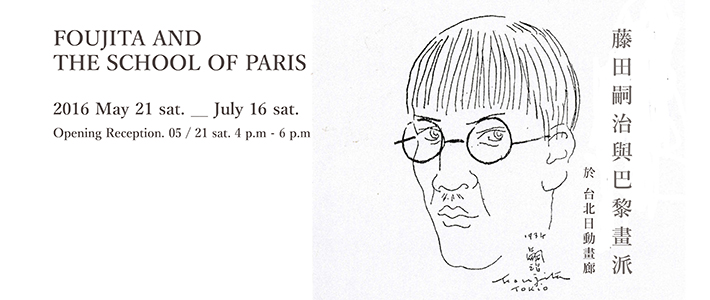藤田嗣治與巴黎畫派

主辦人/單位: 台北日動畫廊 galerie nichido Taipei
首次展演日期:
2016-05-21
結束展演日期:
2016-07-16
詳細時間說明:
展期│2016. 05. 21 – 2016. 07. 16
開幕│016/05 /21 04:00PM – 06:00PM
時間│週二 (Tues) – 週六 (Sat) 11:00 – 19:00
活動地點:
台北日動畫廊 galerie nichido Taipei
活動地址:
台北市松山區敦化南路一段57號3F-2
----------------------------------------------For English please scroll down--------------------------------------
藝術家|藤田嗣治(Léonard Tsuguharu Foujita)、 瑪莉 ‧ 羅蘭珊(Marie Laurencin)、莫依斯 ‧ 基斯林(Moïse Kisling)、莫里斯 ‧ 尤特里羅(Maurice Utrillo)
開幕|2016.5.21(六)下午4:00-6:00
展期|2016.5.21-2016.7.16
地點|台北日動畫廊(台北市敦化南路一段57號3樓之二)
網站| http://www.nichido-garo.co.jp/tw/
▍關於本展 ▍
「藤田嗣治的藝術裡有魔術師般的一面,他的作品綻放如日本故事中誘惑孩童的花朵,但勾勒出外型的線條,卻帶著一種奇異的敏感度與穩定性。」- 安德烈‧華諾(二十世紀初藝評家)
二十世紀初至二次世界大戰之間,一群活躍巴黎的藝術家被總括為「巴黎畫派」(École de Paris, School of Paris)。巴黎畫派並沒有強烈的美學主張,然而成員對追尋自我表現風格的執著,卻是殊途同歸。1920 年代的巴黎,經歷戰爭的殘酷與經濟震盪的危機,使得藝術家更欲求在短暫無常的生命中,綻放自己全部的光彩。出生東京的藤田嗣治,不但是當時畫壇當中少見的亞洲面孔,更是所有赴巴黎取經的外國畫家中,最早享譽國際成名的巴黎畫派代表。
藤田嗣治自東京美術學校畢業後便赴巴黎發展,與畢卡索(Pablo Picasso)、莫迪里亞尼(Amedeo Modigliani)等人結識。早期創作多以生活中的器皿、動物、女性肖像和兒童故事為主;二戰期間受政府委託曾回到日本繪製戰爭畫;晚年入籍法國、受洗為天主教徒之後,則轉而創作和宗教題材有關的作品。然而綜觀一生,奠定其世界級名聲的,無疑便是以潔淨而富層次的乳白色肌理,搭配細緻筆墨線條所描繪的女性裸體畫。
藤田嗣治的「乳白色時期」,讓人聯想到清澈光透的東方白瓷,東洋傳統繪畫中的平面裝置性構圖,浮世繪般纖細靈活的描線,以及剔除繁複色彩的極簡色調;這些元素不僅攫獲西方人的目光與讚嘆,更提點眾多爭相學習西洋畫的日本畫家們,自己文化傳統中未曾留意到的奧秘。藤田的成功,象徵東洋美學入主西洋主導的近代藝壇,透過兩者巧妙的結合,展現藝術表現形式的多元可能。
藤田的一生曲折波瀾,其於藝術創作史上的地位,直到去世後才真正受到肯定。作為藝術家在世時便結有深交的畫廊,在此誠摯邀請各位朋友,一同與我們回顧當時巴黎畫派時代的藝術群像,以及藤田嗣治獨特的藝術世界。
========================================================================
Artists|Léonard Tsuguharu Foujita, Marie Laurencin, Moïse Kisling, Maurice Utrillo
Opening reception |2016.5.21(六)下午4:00-6:00
Dates|2016.5.21-2016.7.16
Venue|galerie nichido Taipei (3F-2, No.57, Sec.1, Dunhua South Road, Taipei 10557, Taiwan)
Website| http://www.nichido-garo.co.jp/tw/english/exhibition/2016/05/post-3.html
▍About the Exhibition ▍
“In the art of Foujita, there is a little bit of the magicians`s art, and even the illusionist`s. His paintings bloom like the Japanese Paper flowers children love, yet the outlines that he depicts carry a strange sense of sensitivity and stability.” - André Warnod (Art Critic during the early 20th Century )
Between the beginning of the 20th Century till the starting of the World War II, Paris became a magnet for artists from all over the world and a centre for artistic activity. The “School of Paris" (École de Paris) was used to describe this broad affiliation, particularly of non-French artists. The School of Paris does not have a strong aesthetical statement, but the members all dedicate themselves in pursuing one`s own expressive style. During the 1920`s, Paris was undergoing the horror of war as well as the economic crisis. This atmosphere pushed the artists to see art as their only purpose in such a short, impermanent life. Foujita Tsuguharu, who was born in Tokyo, was one of the rare Asian faces within the Paris art scene. He was also one of the earliest foreign artists among the School of Paris to be highly appraised right after his debut.
After his graduation from the Western course of painting at the Tokyo School of Fine Art, Foujita went to Paris and settled in the artists` community “Montparnasse” in Paris. There he became acquainted with artists such as Picasso and Modigliani. His early works are mostly paintings of still lifes, animals, female portraits, and stories related to children. During World War II, he was appointed as military painter by the Japanese government and created war paintings. In his later life, he became French citizen, converted to Catholic, and focused mainly on religious issues. However, the main theme that established his international fame was a composition of clean white texture full of abundant layers, together with the thin ink outlines that further combines into a series of luring nude paintings.
Foujita`s works during this “milky white period” contain shades of white that relate to white porcelain, delicate lines from the Ukiyo-e tradition, and monotone compositions; these traits not only stuns the audience from the West, they also remind Japanese painters of their own mystic cultural traditions that have been rarely noticed before. Foujita’s huge talent is represented by its ability to bring artistic awareness of the East into the modern art world that was previously dominated by the West, and further demonstrate the plentiful possibilities with the combination of both.
Living an intricate life, Foujita`s position in art history has only come to receive real value after his death. As a gallery who holds a long relationship since his time of living, we sincerely invite all guests to visit our gallery to sense the atmosphere of the time of the School of Paris, and the unique art world of Foujita Tsuguharu.
活動聯絡電話: 02-2579-8795 活動聯絡人: 台北日動畫廊







